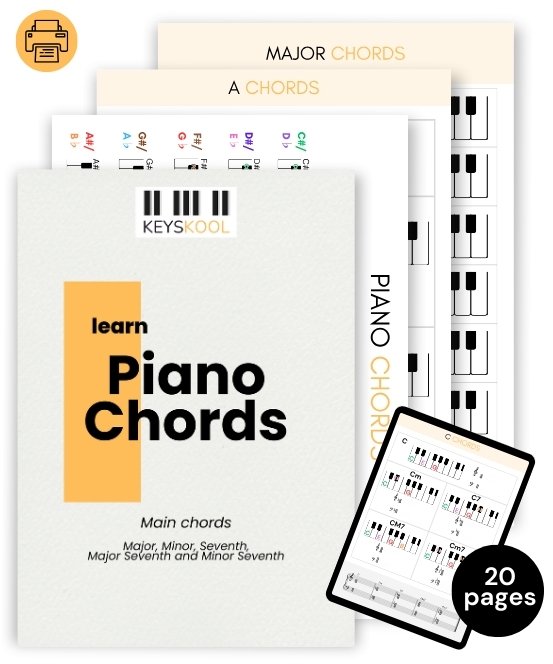A piano chord is a combination of three or more musical notes played simultaneously on a piano. These notes create a harmonious sound when struck together, forming the basic building blocks of harmony in music. Piano chords come in various types, with major and minor chords being the most fundamental.
They play a crucial role in providing structure, depth, and emotion to musical compositions, serving as the foundation upon which melodies are built. Learning piano chords is essential for musicians as it opens up a world of creative possibilities, enabling them to express a wide range of emotions through their playing.
Don’t worry. You don’t need to learn them all from the beginning. Actually there are a huge range of classical and modern songs that are based on simple piano chords.
List of different types of piano chords
Okay, I’ll give you the list of piano chords, if you promise you won’t learn them by heart:
Major Chords: A root note, a major third, and a perfect fifth.
Minor Chords: A root note, a minor third, and a perfect fifth.
Seventh Chords: Extends the basic triad with a seventh note.
Diminished Chords: A root note, a minor third, and a diminished fifth (a what?)
Augmented Chords: A root note, a major third, and an augmented fifth (still confused)
Major Seventh Chords: Adds a major seventh to the major triad (okay now it’s chemestry)
Minor Seventh Chords: Adds a minor seventh to the minor triad.
Diminished Seventh Chords: Combines a diminished triad with a diminished seventh.
Dominant Seventh Chords: Combines a major triad with a minor seventh.
Major Ninth Chords: Extends the major seventh chord with a ninth.
Minor Ninth Chords: Combines a minor seventh chord with a ninth (wouffff)

And there are also the inversions…
You think you’re done? There are actually and infinity of piano chords out there and each music style has its own favorite range of piano chords.
Read: The Importance of Chord Knowledge for Pianists – Makingmusicmag.com
All minor and major piano chords
But to start your piano journey, you can simple start by learning the basic major and (natural) minor chords.
Major Chords:
C Major (C): C – E – G
D Major (D): D – F# – A
E Major (E): E – G# – B
F Major (F): F – A – C
G Major (G): G – B – D
A Major (A): A – C# – E
B Major (B): B – D# – F#
Natural Minor Chords:
A Minor (Am): A – C – E
B Minor (Bm): B – D – F#
C Minor (Cm): C – E♭ – G
D Minor (Dm): D – F – A
E Minor (Em): E – G – B
F Minor (Fm): F – A♭ – C
G Minor (Gm): G – B♭ – D
The Importance of Learning Piano Chords for Beginners
Familiarize yourself with basic music theory
Learning piano chords lays a solid foundation for grasping the language of music.
It demystifies the piano, making it more approachable and less daunting for newcomers.
Knowing the theory behind chords, such as how they’re constructed, will deepen your understanding and make learning more meaningful.
Musical Versatility
From classic to pop, to RnB to ballad to Movie music. Chords are everywhere !
You don’t know yet but you already know most of them.
Learning chords is like breaking a song in small blocks, allowing you to understand the music composition and why not, start compose music yourself.

Expressive Playing
To be very very simple : major chords are happy, minor chords are sad. Simple isn’t it ?
But this is just the beginning.
Each chord carries its unique emotion, allowing players to convey feelings and moods in their music.
As you will learn more and more chords, you will feel like you understand the language of music and feel deeper tthe emotions brought by the symbiosis of notes.
Creating Your Music
As you will become familiar with chords, you gain the ability to compose you own music.
It nurtures a sense of ownership and creativity in your musical journey.
You can actually start composing your own music using the most simple piano chords.
Ear Training
Chord practice sharpens the ears, helping you to recognize chords by sound.
This skill is invaluable for playing by ear and improvisation.
You 10 chords away from your 1st jazz improvisation 😀 ;D
Build flexibility and strengthen fingers
Along with scales exercices, practicing chords will build fingers strenght and muscle memory for your future songs.
With time, your fingers will find their places naturally on the keyboard.
Fun Learning Experience
From all the technical challenge you will face during your piano journey, learning chords is one the easiest exercices. Moreover if you start by learning simple piano chords like major and minor at first.
That’s why learning piano chords is so rewarding, enjoyable and fun, making the practice sessions more engaging and motivating.

Printable how to play a piano chords PDF with beautiful charts
Decoding piano chords and learning main and most famous and usefull chords made easy with our beautiful charts. Download, print and display next to your practice place.
“Music is the divine way to tell beautiful, poetic things to the heart.”
– Pierre Auguste Renoir
A step-by-step guide to learn basic piano chords for beginners
Step 1: Learn 1 or 2 chords at the time.
Easy beasy, you don’t need to learn them all from the 1st day. Give yourself some time.
Repeat the chord from pianissimo to fortissimo, from slow to fast, ascending and descending.
Step 2: Hands-On Practice:
Begin playing the chords with your right hand first, then introduce your left hand.
Focus on maintaining a relaxed hand position to ensure comfort and ease of movement.
Step 3: Learn in the right order
Start by playing the chords in the same order.
Keep together the chords with the same fingering.
Than mix them all!
Step 4: Start with the basics – the major chords.
Focus on the primary major chords: C, D, E, F, G, A, B.
Each major chord consists of a root note, a major third, and a perfect fifth.
Start by playing the notes separately than all together.
Step 5: Learn the Natural Minor Chords:
Now, delve into natural minor chords. Practice the minor chords corresponding to C, D, E, F, G, A, B.
Try to feel the difference between the major chord and the minor corresponding chord.
Do you ear the change of mood and emotion?

Step 6: Master Chord Transitions:
Practice transitioning smoothly between chords starting with those major and natural minor simple piano chords.
Slow down the tempo if needed to ensure accuracy.
This step builds muscle memory and enhances your overall playing proficiency.
Step 7: Mix them all!
Increase your speed!
Have fun!
The best tips for easy piano chords learning
Practice Hand Positioning
Pay attention to hand positioning.
Keep your fingers relaxed and curved, and try to play with the tips of your fingers.
This will enhance your control and finger strength.
Use a Metronome for Timing
Incorporate a metronome into your practice.
It helps you maintain a steady tempo and develop a sense of timing, crucial for playing chords in rhythm.
Play by Ear
Train your ear by listening to the chords. Try identifying them in the music you enjoy.
This skill improves your ability to play by ear and adds a layer of intuition to your playing.
Consistent Practice
Dedicate regular practice sessions to chord exploration. Consistency is key to building proficiency.
You can start all you practices sessions with 10 minutes of chords.
But don’t you dare play chords for hours, you will get bored.
Read: Common Chord Progressions and How to Make Them Your Own – Berklee.edu
Embrace the Learning Process learning simple piano chords.
Enjoy the learning journey. Celebrate small victories and milestones along the way.
Progress takes time. Learning piano chords is a gradual process, so be patient with yourself.
Be patient, stay consistent with your practice, and celebrate small victories along the way.
Remember, the key is consistent practice and a positive mindset.
